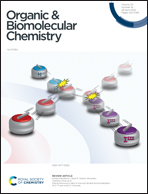A dual-response fluorescent probe for N2H4 and viscosity in living cells and zebrafish to evaluate liver injury†
Abstract
Hydrazide drugs can cause severe drug-induced liver injury owing to the enzymatic release of N2H4 in the liver. Also, changes in cellular viscosity are associated with liver damage. Thus, simultaneous monitoring of changes in N2H4 levels and viscosity can be used to evaluate the side effects of hydrazide drugs. Herein, we firstly reported a near-infrared fluorescent probe (FNN), which contains 1,8-naphthalimide as the fluorophore and a chalcone moiety as the responsive receptor, for sensitively detecting intracellular viscosity and N2H4. FNN showed a fast ‘turn-on’ fluorescence response to N2H4 with excellent selectivity. Additionally, FNN could selectively track viscosity without interference from polarity, pH, and other active species. Furthermore, imaging experiments suggested that FNN could be successfully applied in living cells and zebrafish larvae and embryos, which is of great importance for effectively assessing the degree of liver injury.



 Please wait while we load your content...
Please wait while we load your content...